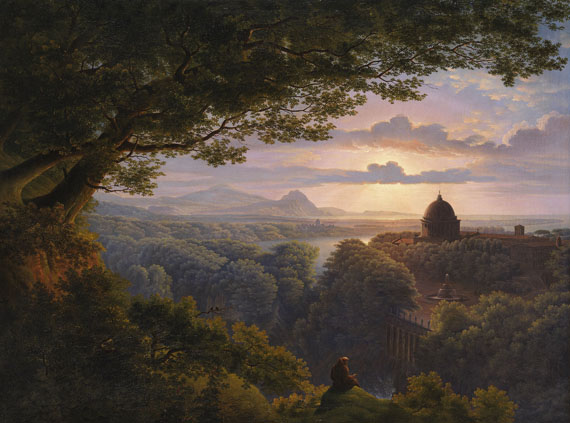Dictionary


French Classicism
Classicism was, in many cultural circles, primarily restricted to an elite, humanist-educated public. In France, however, neoclassicism (which should be distinguished from baroque classicism) was partially linked to revolutionary bourgeois aims. Thus in its early form, classicism was an art of the people, and was only later used for imperial-propagandist purposes. The style came from Italy and was significantly shaped by Mengs and Winckelmann. From the 1760s, classicism spread throughout France, with Paris becoming its centre. The first exponent of the style was Joseph-Marie Vien (1716-1809), who supplanted dynamic, sensual rococo with early neoclassicism, embellished with baroque elements. Vien’s most talented student was Jacques-Louis David (1748-1825), who made the decisive step towards high classicism with his celebrated work "The Oath of the Horatii" (now in the Louvre). The relief-like composition, with its emphasis on foreground, and clear, corporeal, linear structure, is neoclassicism in its purest form. It is also a key example of neoclassical revolutionary and pre-revolutionary propaganda art. The painter, who was very politically active, often used historical and mythological scenes in his political paintings. Following Napoleon’s seizure of power, David devoted his entire work to the new ruler, whom he glorified in images such as "Bonaparte Crossing the Alps". David influenced a number of political, classical artists such as his student Antoine-Jean Gros (1771-1835). Following the revolution, a second strand of French neo-classicism developed, which promoted aesthetic and emotional values. Harmony, ideals, beauty and sentimentality became dominant themes. Pierre-Paul Prud`hon, and François Gérard (1770-1837) executed soft and sensitive paintings which enriched David’s style with a dreamy sensuality.
Another of David’s students, whose work was, however, not particularly influenced by him, was the painter Anne Louis Girodet-Trioson (1767-1824). Jean-Auguste Dominique Ingres (1780-1867) saved the classical style from the powerful, emerging French romantic style, and his portraits of young girls are early examples of the neo-renaissance style.
Classicism was, in many cultural circles, primarily restricted to an elite, humanist-educated public. In France, however, neoclassicism (which should be distinguished from baroque classicism) was partially linked to revolutionary bourgeois aims. Thus in its early form, classicism was an art of the people, and was only later used for imperial-propagandist purposes. The style came from Italy and was significantly shaped by Mengs and Winckelmann. From the 1760s, classicism spread throughout France, with Paris becoming its centre. The first exponent of the style was Joseph-Marie Vien (1716-1809), who supplanted dynamic, sensual rococo with early neoclassicism, embellished with baroque elements. Vien’s most talented student was Jacques-Louis David (1748-1825), who made the decisive step towards high classicism with his celebrated work "The Oath of the Horatii" (now in the Louvre). The relief-like composition, with its emphasis on foreground, and clear, corporeal, linear structure, is neoclassicism in its purest form. It is also a key example of neoclassical revolutionary and pre-revolutionary propaganda art. The painter, who was very politically active, often used historical and mythological scenes in his political paintings. Following Napoleon’s seizure of power, David devoted his entire work to the new ruler, whom he glorified in images such as "Bonaparte Crossing the Alps". David influenced a number of political, classical artists such as his student Antoine-Jean Gros (1771-1835). Following the revolution, a second strand of French neo-classicism developed, which promoted aesthetic and emotional values. Harmony, ideals, beauty and sentimentality became dominant themes. Pierre-Paul Prud`hon, and François Gérard (1770-1837) executed soft and sensitive paintings which enriched David’s style with a dreamy sensuality.
Another of David’s students, whose work was, however, not particularly influenced by him, was the painter Anne Louis Girodet-Trioson (1767-1824). Jean-Auguste Dominique Ingres (1780-1867) saved the classical style from the powerful, emerging French romantic style, and his portraits of young girls are early examples of the neo-renaissance style.
Offers
Headquarters
Joseph-Wild-Str. 18
81829 Munich
Phone: +49 89 55 244-0
Fax: +49 89 55 244-177
info@kettererkunst.de
Louisa von Saucken / Undine Schleifer
Holstenwall 5
20355 Hamburg
Phone: +49 40 37 49 61-0
Fax: +49 40 37 49 61-66
infohamburg@kettererkunst.de
Dr. Simone Wiechers / Nane Schlage
Fasanenstr. 70
10719 Berlin
Phone: +49 30 88 67 53-63
Fax: +49 30 88 67 56-43
infoberlin@kettererkunst.de
Cordula Lichtenberg
Gertrudenstraße 24-28
50667 Cologne
Phone: +49 221 510 908-15
infokoeln@kettererkunst.de
Hessen
Rhineland-Palatinate
Miriam Heß
Phone: +49 62 21 58 80-038
Fax: +49 62 21 58 80-595
infoheidelberg@kettererkunst.de
We will inform you in time.




